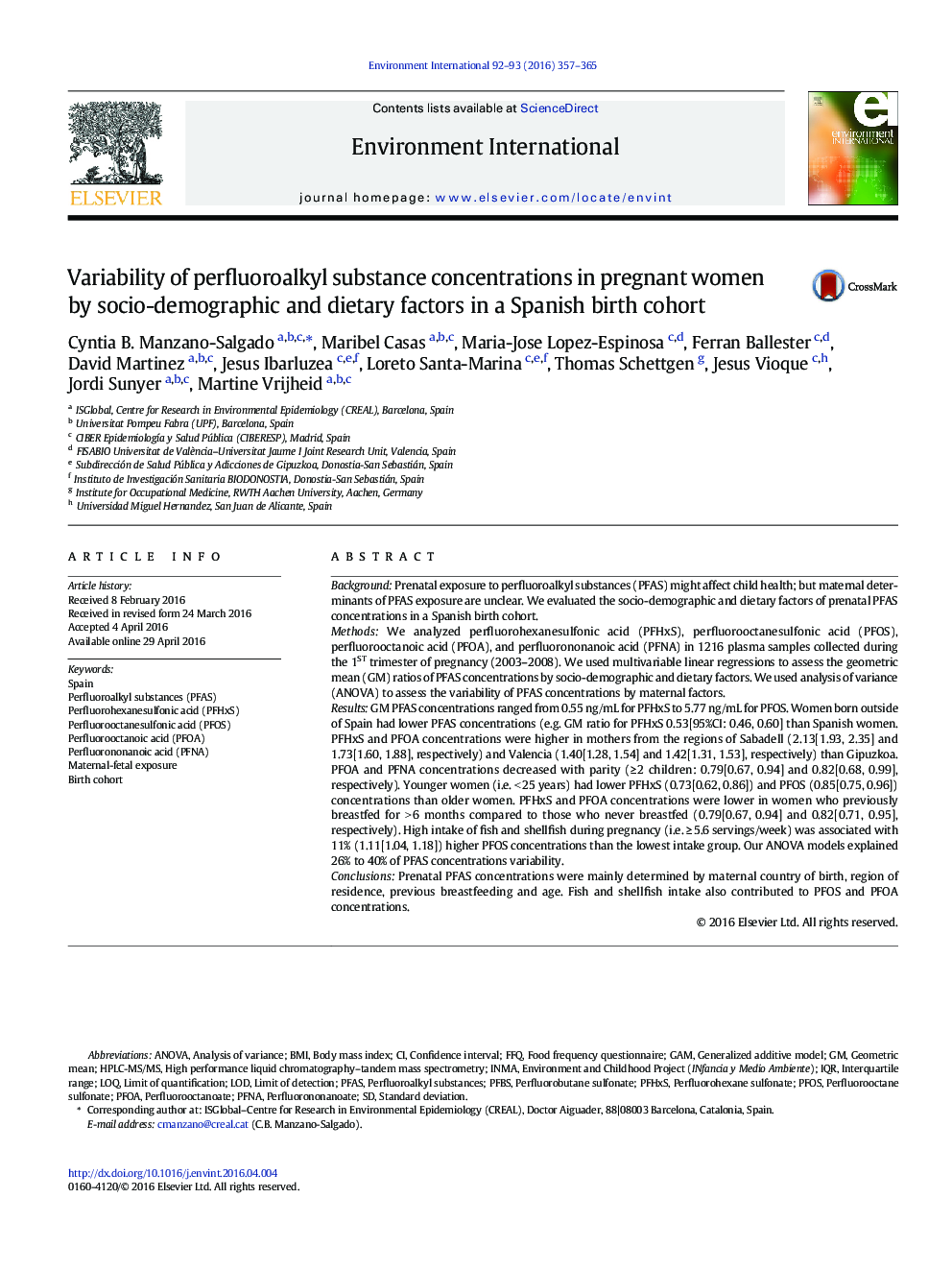| کد مقاله | کد نشریه | سال انتشار | مقاله انگلیسی | نسخه تمام متن |
|---|---|---|---|---|
| 6313006 | 1619037 | 2016 | 9 صفحه PDF | دانلود رایگان |
- Pregnant women in Spain were ubiquitously exposed to PFAS during 2003-2008.
- Mean PFAS concentrations ranged from 0.55Â ng/mL for PFHxS to 5.77Â ng/mL for PFOS.
- Main PFAS predictors were maternal country of birth, region, breastfeeding and age.
- Fish and shellfish intake was the main dietary predictor of PFOS and PFOA.
BackgroundPrenatal exposure to perfluoroalkyl substances (PFAS) might affect child health; but maternal determinants of PFAS exposure are unclear. We evaluated the socio-demographic and dietary factors of prenatal PFAS concentrations in a Spanish birth cohort.MethodsWe analyzed perfluorohexanesulfonic acid (PFHxS), perfluorooctanesulfonic acid (PFOS), perfluorooctanoic acid (PFOA), and perfluorononanoic acid (PFNA) in 1216 plasma samples collected during the 1ST trimester of pregnancy (2003-2008). We used multivariable linear regressions to assess the geometric mean (GM) ratios of PFAS concentrations by socio-demographic and dietary factors. We used analysis of variance (ANOVA) to assess the variability of PFAS concentrations by maternal factors.ResultsGM PFAS concentrations ranged from 0.55 ng/mL for PFHxS to 5.77 ng/mL for PFOS. Women born outside of Spain had lower PFAS concentrations (e.g. GM ratio for PFHxS 0.53[95%CI: 0.46, 0.60] than Spanish women. PFHxS and PFOA concentrations were higher in mothers from the regions of Sabadell (2.13[1.93, 2.35] and 1.73[1.60, 1.88], respectively) and Valencia (1.40[1.28, 1.54] and 1.42[1.31, 1.53], respectively) than Gipuzkoa. PFOA and PFNA concentrations decreased with parity (â¥Â 2 children: 0.79[0.67, 0.94] and 0.82[0.68, 0.99], respectively). Younger women (i.e. < 25 years) had lower PFHxS (0.73[0.62, 0.86]) and PFOS (0.85[0.75, 0.96]) concentrations than older women. PFHxS and PFOA concentrations were lower in women who previously breastfed for > 6 months compared to those who never breastfed (0.79[0.67, 0.94] and 0.82[0.71, 0.95], respectively). High intake of fish and shellfish during pregnancy (i.e. â¥Â 5.6 servings/week) was associated with 11% (1.11[1.04, 1.18]) higher PFOS concentrations than the lowest intake group. Our ANOVA models explained 26% to 40% of PFAS concentrations variability.ConclusionsPrenatal PFAS concentrations were mainly determined by maternal country of birth, region of residence, previous breastfeeding and age. Fish and shellfish intake also contributed to PFOS and PFOA concentrations.
Journal: Environment International - Volumes 92â93, JulyâAugust 2016, Pages 357-365
